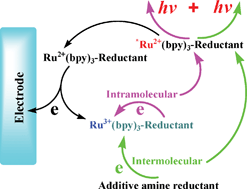Intra- and intermolecular interaction ECL study of novel ruthenium tris-bipyridyl complexes with different amine reductants
Abstract
A series of ruthenium(II) tris-bipyridyl complexes covalently linked with different

* Corresponding authors
a State Key Laboratory of Fine Chemicals, Dalian University of Technology, No. 158-40, Zhongshanlu, Dalian, China
b Department of Chemistry and State Key Laboratory of Fine Chemicals, Dalian University of Technology, No. 2, Linggonglu, Dalian, China
c Department of Physiology and Pharmacology, Pharmacological Neurochemistry, Karolinska Institutet, Stockholm, Sweden
d Department of Chemistry, Organic Chemistry, School of Chemical Science and Engineering, Royal Institute of Technology (KTH), Teknikringen 30, Stockholm, Sweden
A series of ruthenium(II) tris-bipyridyl complexes covalently linked with different

 Please wait while we load your content...
Something went wrong. Try again?
Please wait while we load your content...
Something went wrong. Try again?
S. Sun, Y. Yang, F. Liu, J. Fan, X. Peng, J. Kehr and L. Sun, Dalton Trans., 2009, 7969 DOI: 10.1039/B905404A
To request permission to reproduce material from this article, please go to the Copyright Clearance Center request page.
If you are an author contributing to an RSC publication, you do not need to request permission provided correct acknowledgement is given.
If you are the author of this article, you do not need to request permission to reproduce figures and diagrams provided correct acknowledgement is given. If you want to reproduce the whole article in a third-party publication (excluding your thesis/dissertation for which permission is not required) please go to the Copyright Clearance Center request page.
Read more about how to correctly acknowledge RSC content.
 Fetching data from CrossRef.
Fetching data from CrossRef.
This may take some time to load.
Loading related content
